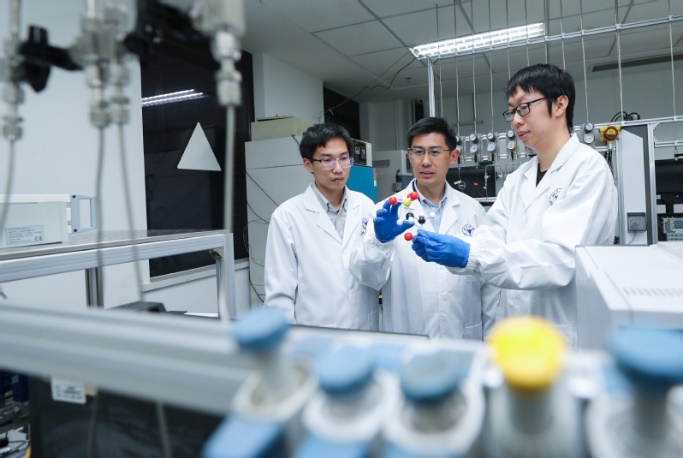Propylene stands as a ubiquitous raw material in our daily lives, serving as a fundamental element in the production of various chemical goods, including plastics, household appliances, medical devices, synthetic fibers, and cosmetics. Undoubtedly, it ranks among the most prolificbulk chemical products globally.
However, there is a formidable challenge in industrial production, where propylene and propane, akin to inseparable companions, coexist, rendering it difficult to separate them. One article in the journal Nature once highlighted that the development of energy-efficient efficient and energy-saving olefin-alkane/paraffin separation technology is one of the seven chemical separation processes that can change the world.

Prof. XING Huabin (middle) and his colleagues in the lab
A breakthrough in this arena comes from the collaborative efforts of Prof. XING Huabin and Prof. YANG Lifeng’s research team at the Zhejiang University College of Chemical and Biological Engineering, Zhejiang University and ZJU-Hangzhou Global Scientific and Technological Innovation Center. Their innovation, molecular sieve ZU-609, features local sieving channels that have molecular sieving gates and rapid diffusion channels, presenting a marked advancement in low-carbonefficient propylene separation.
The research was pPublished as a First Release in the journal Science as a First Release version on December 15, 2023, their findings illuminate a key aspect of chemical engineering.
Propylene and propane, extracted from petroleum refinement, look like “twins”, differing only in two hydrogen atoms. They are virtually identical in size, with a minimal difference of 0.4 Å, or 4% of a nanometer. Therefore, It is for this very reason that it is challenging to rapidly separate sieve propylene and from propane in an accurate and swift manner.
Molecular sieving is a key mechanism for achieving high-selectivity recognition of closely-sized substances. Only molecules with the size that is smaller than the pore of the adsorbent pores adsorbents could access gain entry to the channel, while larger ones are blocked.
It is better read about in theory than carried out in practice. Narrow channels constrain molecular diffusion, and molecular sieving materials have long suffered from grappled the with problems such as poor diffusion mass transfer, low adsorption capacity, and difficult difficulty in desorption, severely hampering its separation efficiency.
“To accelerate the adsorption kinetics of olefinsincrease the rate of olefin passage, industry often resorts to highincreases temperatures to ‘drive away’ gases and make them ‘run’ faster,” said Prof. XINGing Huabin. However, this method compromises the working capacity of the adsorbent and increases energy consumption. “The heat-driven olefin production process contributes about 1% of the global carbon emissions.”
Achieving rapid material mass transfer in limited confined space has always been the research frontiersat the cutting edge of research. Prof. XING Huabin said that olefins and alkanesparaffin can be precisely separated in small vessels in the laboratory, but it may not work on an industrial scale.
Efficient and rapid material mass transfer within confined spaces is crucial, and overcoming this challenge is pivotal for enhancing chemical process efficiency on an industrial scale. To this end, the researcher team developed ZU-609, a fast, efficient, and low-carbonnovel molecular sieve with fast adsorption kinetics. By meticulously controlling pore openings, this molecular sieve only adsorb propylene while exclude propane, selectively allows propylene molecules to permeate while obstructing propane molecules, achieving rapid and precise recognition.
In order to enhance olefin diffusion efficiencymake the separation process faster, the research team devised sieving channels which are “small at both ends and large in the middle”. “Isolation piers” are placed at the entrance and exit of the channel to block propane molecules. Propylene, once in the channel, can quickly pass through the broad middle section, increasing the diffusion coefficient by one to two orders of magnitude compared to previous molecular sieves.
The efficiency of separation is demonstrated by the acquisition of propylene with 99.97% purity from an equimolar propylene-propane mixture through the ZU-609 molecular sieve. Moreover, ZU-609 is easy to be regenerated shows remarkable desorption and regeneration capabilities, achieving complete material regeneration at room temperature through nitrogen purging or vacuum pumping.
“The new molecular sieve can not only capture propylene molecules but also release them quickly, laying the foundation for the development of efficient and low-carbon separation of technology of propylene,” observed Prof. YANG Lifeng said.
“Our research provides new insights into the core issue of micro-porous diffusion mass transfer enhancement in chemical engineering and sets the stage for the development of low-carbon separation technology,” Prof. XING Huabin concluded. This is also instrumental to the domestic production of ultra-high-purity electronic chemicals.

